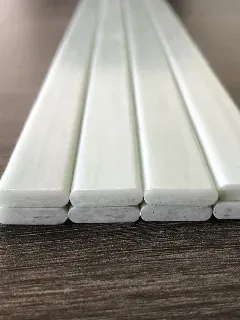loading...
- No. 9, Xingyuan South Street, Dongwaihuan Road, Zaoqiang County, Hengshui, Hebei, China
- admin@zjcomposites.com
- +86 15097380338
- Welcome to visit our website!
Exploring the Benefits of Structural Fiberglass Reinforced Polymer in Engineering Applications
Understanding Structural FRP Fiberglass A Modern Material for Innovative Applications
Fiberglass Reinforced Polymer (FRP) has emerged as a revolutionary material in various industries due to its unique combination of strength, light weight, and resistance to corrosion. This article aims to explore the properties, applications, and advantages of structural FRP fiberglass, highlighting its significance in modern engineering and construction.
What is Structural FRP Fiberglass?
Structural FRP fiberglass is composed of a polymer matrix reinforced with glass fibers. The glass fibers impart strength and rigidity, while the polymer matrix provides flexibility and resistance to environmental factors. This composite material can be tailored to meet specific performance requirements, making it suitable for a wide range of structural applications.
Key Properties of FRP Fiberglass
1. Lightweight One of the most significant advantages of FRP fiberglass is its lightweight nature. Compared to traditional materials like steel and concrete, FRP is approximately one-fifth the weight of steel, making it easier to handle, transport, and install.
2. High Strength-to-Weight Ratio Despite its lightness, FRP fiberglass boasts an impressive strength-to-weight ratio, allowing for the creation of strong and durable structures without the associated weight of conventional materials.
3. Corrosion Resistance FRP fiberglass is resistant to a variety of environmental factors, including moisture, chemicals, and extreme temperatures. This quality makes it ideal for applications in harsh environments, such as marine and chemical processing facilities.
4. Low Thermal Conductivity The material’s insulation properties are beneficial in applications where temperature control is crucial. FRP does not conduct heat as efficiently as metals, reducing energy costs in temperature-sensitive applications.
5. Design Flexibility FRP can be molded into complex shapes, allowing for innovative designs that may not be feasible with traditional materials. This flexibility opens up new possibilities in architecture and engineering.
Applications of Structural FRP Fiberglass
1. Construction and Infrastructure FRP is increasingly being used in building and civil engineering projects. Its lightweight and corrosion-resistant nature makes it suitable for bridges, decks, and reinforcements in structures exposed to harsh conditions.
structural frp fiberglass

2. Aerospace and Transportation The aerospace industry utilizes FRP fiberglass for its lightweight characteristics, enhancing fuel efficiency in aircraft. It is also used in automotive applications to reduce vehicle weight.
3. Marine Industry The maritime environment poses significant challenges due to saltwater corrosion. FRP fiberglass is used for boat hulls, docks, and supports in marine structures, prolonging service life and reducing maintenance costs.
4. Wind Energy Wind turbine blades are often made from FRP, as the material can be molded into aerodynamic shapes that maximize energy capture while remaining lightweight.
5. Electrical and Telecommunications FRP is used in applications such as electrical enclosures and telecommunications towers due to its excellent insulating properties and resistance to electromagnetic interference.
Advantages of Using FRP Fiberglass
The advantages of incorporating structural FRP fiberglass into various applications are numerous
- Reduced Maintenance Costs The corrosion resistance of FRP leads to lower maintenance requirements over the lifespan of structures, resulting in long-term savings.
- Sustainability FRP can be manufactured from recycled materials, and its longevity contributes to sustainability efforts in construction and manufacturing.
- Improved Safety The lightweight nature of FRP reduces the risk of injuries during handling and installation, promoting a safer work environment.
- Enhanced Aesthetic Appeal The ability to mold FRP into complex shapes allows for innovative and visually appealing designs in architecture.
Conclusion
As industries continue to seek materials that offer superior performance, durability, and sustainability, structural FRP fiberglass stands out as a compelling choice. Its unique properties and versatility enable it to meet the demands of modern engineering challenges, paving the way for innovation in construction, transportation, and beyond. With ongoing advancements in manufacturing processes and applications, FRP fiberglass is poised to play a vital role in shaping the future of material science and structural engineering.
-
The Rise of FRP Profiles: Strong, Lightweight, and Built to LastNewsJul.14,2025
-
SMC Panel Tanks: A Modern Water Storage Solution for All EnvironmentsNewsJul.14,2025
-
GRP Grating: A Modern Solution for Safe and Durable Access SystemsNewsJul.14,2025
-
Galvanized Steel Water Tanks: Durable, Reliable, and Ready for UseNewsJul.14,2025
-
FRP Mini Mesh Grating: The Safer, Smarter Flooring SolutionNewsJul.14,2025
-
Exploring FRP Vessels: Durable Solutions for Modern Fluid HandlingNewsJul.14,2025
-
GRP Structures: The Future of Lightweight, High-Performance EngineeringNewsJun.20,2025
